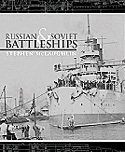 Russian & Soviet Battleships, by Stephen McLaughlin, Naval Institute Press, 2003, $89. 95, ISBN 1-55750-481-4, 497 pp
Russian & Soviet Battleships, by Stephen McLaughlin, Naval Institute Press, 2003, $89. 95, ISBN 1-55750-481-4, 497 pp
If you are at all interested in battleships or the Russian or Soviet Navy, then you should buy this book. Mr. McLaughlin has written the de . nitive work on this topic. Illustrated with beautiful drawings and sharp photos, the author covers each battleship class in comprehensive detail. Starting with Petr Velikii, the first Russian ship capable of being called a battleship, he includes complete details of the design process and construction, armor, armament, and propulsion systems. He also lists modifications to each class, and provides a short narrative on the career of individual vessels. The sheer amount of information, heretofore unpublished in English, puts this work in the same league as the battleship trilogy by William H. Garzke, Jr and Robert O. Dulin, Jr.
This book was of immense help as we created the data annex for our product on the Russo-Japanese War, Dawn of the Rising Sun . One example of the depth of Mr. McLaughlin’s research was the detailed explanation as to why the most modern Russian battleship of that era, the Borodino class of pre-dreadnoughts, had the worst belt armor. Although the Borodino class was based on the French-designed and -built Tsesarevich, the Russian naval architects placed greater emphasis on protection for the guns, and added a flawed antitorpedo defense concept that left the Borodino class significantly overweight. The designers reduced the weight back to acceptable limits by thinning out the belt armor.
In addition to the details of the design and construction, he also provides some political context for many of the designs. For example, in Chapter 41, The Oceanic Fleet, 1935 -1941, he covers Stalin’s purges and their devastating effect on the Soviet Navy. Starting in 1937, four successive heads of the navy were arrested and executed in the space of nineteen months. Three thousand naval officers were imprisoned or executed. Stalin’s purge affected not only the navy, but also the ship design bureaus as well. Many senior officials were arrested, and so many other workers were imprisoned, that the NKVD started its own ship design bureau within the Gulag.
Mr. McLaughlin’s Russian language skills, and some very impressive contacts within Russia, has provided the English-speaking world a rare and wonderful glimpse into the Russian/Soviet battleship designer. And while the book is a bit on the expensive side, the author has earned every kopeck.
BT
Back to The Naval Sitrep # 26 Table of Contents
Back to Naval Sitrep List of Issues
Back to MagWeb Master Magazine List
& copy Copyright 2004 by Larry Bond and Clash of Arms.
This article appears in MagWeb.com (Magazine Web) on the Internet World Wide Web.
Other military history and related articles are available at http://www.magweb.com